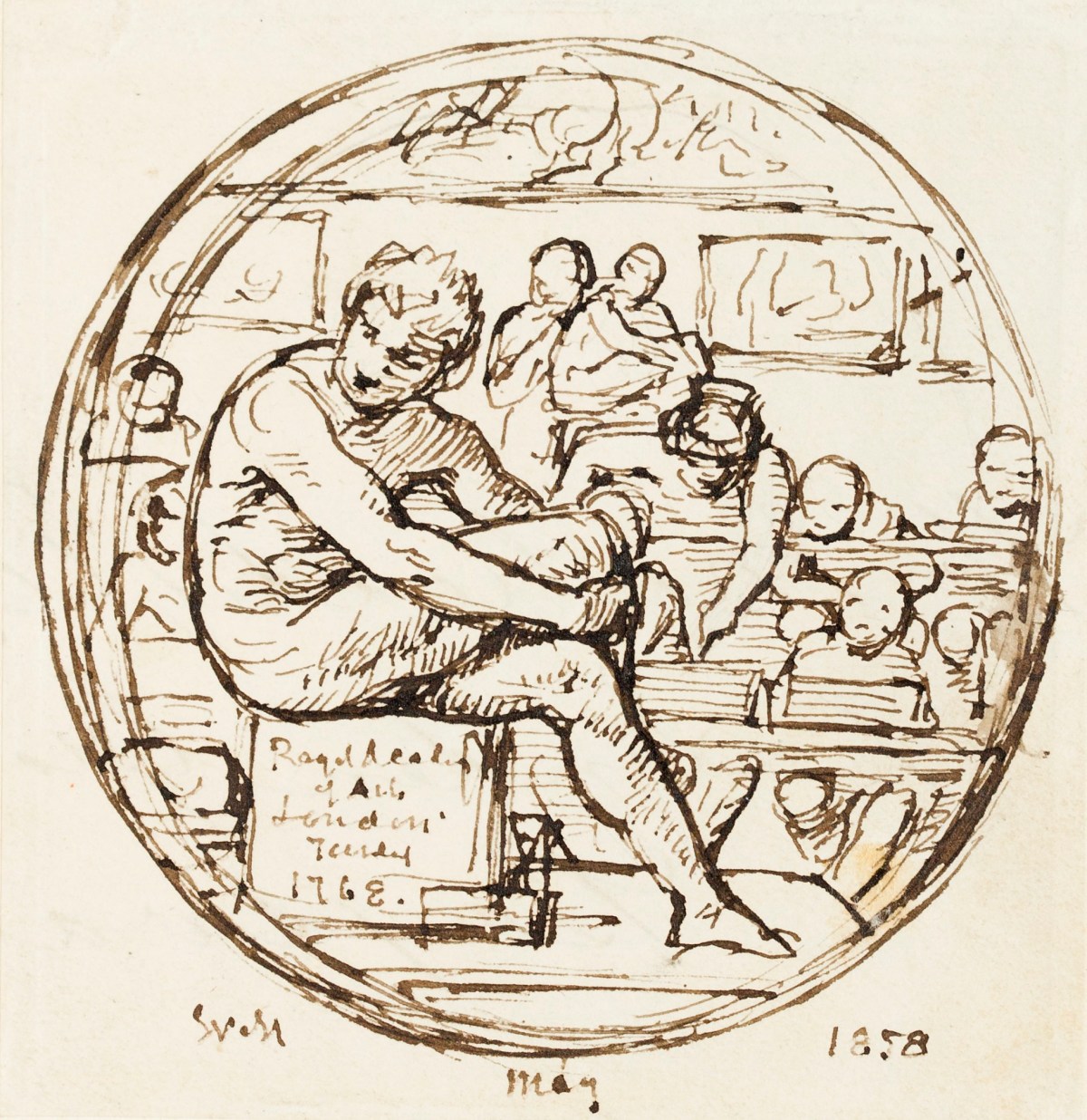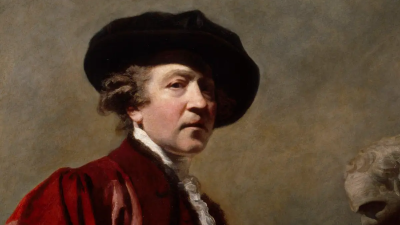
William Mulready RA, A design for the reverse of a Royal Academy medal, May 1858.
Pen and ink on cream wove paper (back of an envelope addressed to mulready). 76 mm x 72 mm. © Photo: Royal Academy of Arts, London.
This image is not available to download. To licence this image for commercial purposes, contact our Picture Library at picturelibrary@royalacademy.org.uk
A design for the reverse of a Royal Academy medal, May 1858
William Mulready RA (1786 - 1863)
RA Collection: Art
A design for the reverse of a Royal Academy medal, probably the Turner prize, showing students at work drawing a male model in the Life Room of the Royal Academy Schools.
In 1857 the RA Council voted to establish a prize for landscape painting in memory of J. M. W. Turner, following the terms of the artist's will. Producing a prize medal for this award, however, proved to be a lengthy process. E. H. Baily was originally chosen to execute the medal but the Council did not approve the model he produced (see Council Minutes 9 November 1857). On 3 December 1857 the minutes record that 'the thanks of the Council were voted to Mr Dyce - for a medallion drawing of the head of Mr Turner which he had made and presented to the Academy as a suggestion for the obverse of the Turner medal'. This design being accepted, all Academicians were then invited to produce a design for the reverse of the medal which, it was suggested, should be a 'composition having reference to the purpose of the premium' (C.M. 9 January 1858). As only one drawing was received in response to this request, Mulready, Dyce and Maclise were subsequently invited to submit designs (see C.M., 5 June 1858). The date on this sketch suggests that Mulready was already working on a design for the obverse before receiving the official invitation. However, it seems odd that Mulready chose to depict students at work in the Life Room rather than a landscape theme and, though the date suggests that this drawing relates to the Turner medal, it is possible that it is in fact for a different medal - possibly one for life drawing.
After a meeting of the General Assembly to choose the artist by ballot, Maclise's design was selected and was struck by Leonard Wyon in 1859 (see 08/2788 and 05/5097). The Royal Academy collection also includes Dyce's design for the reverse of the medal (03/152).
This sheet is attached to p. 136 in Volume VII of E. B. Jupp's extra-illustrated Royal Academy exhibition catalogues.
This work comes from one of sixteen volumes of Royal Academy Annual Exhibition catalogues that were collected and extra-illustrated by the lawyer and antiquarian Edward Basil Jupp F.S.A. (1812 - 1877). The catalogues span the period from the first annual exhibition in 1769 up to 1875. Jupp added drawings, prints, letters and autographs by, or referring to, Academicians and other exhibitors at the Academy's annual exhibition.
E.B. Jupp was a solicitor who married Eliza Kay, daughter of the architect William Porden Kay. He was a Fellow of the Society of Antiquaries and a clerk of the Carpenters' Company, of which he published a history. Jupp amassed a large collection of paintings by British and Dutch artists, drawings, prints, books and porcelain most of which was sold after his death, at Christie's in February 1878.
Many of the drawings in Jupp's Royal Academy extra-illustrated volumes were bought from art sales during the 1860s. He was also acquainted with a number of contemporary artists and several drawings in the later volumes (along with many of the letters and autographs) were sent from the artists themselves.
Following years of deliberation over the will of J. M. W. Turner, the Royal Academy eventually received a sum of £20,000 from his estate in 1856. The Academy's Council Minutes record that it was agreed the funds should be used "in conformity with the will of the late J. M. W. Turner" for "a medal to be called 'Turner's medal' equal in value to the Gold medal now given by the Royal Academy be awarded to the best landscape painting at the Biennial Distribution".
Producing a medal for this award, however, proved to be a lengthy process. Initially, in November 1856, the Council resolved that the design for the medal should be decided by a public competition, with prizes awarded for the best and the second best designs. However, in February the following year, they revoked their original decision as it was deemed "on many accounts objectionable". Instead the Council requested the Academician and sculptor E. H. Baily be invited to provide a design for the medal.
However, despite producing two different models, E. H. Baily's designs were not considered good enough by Council. On 3rd December 1857 RA minutes record that William Dyce had put forward an alternative design for the obverse, with a portrait of Turner shown in profile. This design being accepted, all Academicians were then invited to produce a design for the reverse of the medal which, it was suggested, should be a "composition having reference to the purpose of the premium...It is suggested that the Design need not be elaborate, but should suffice to convey the intended idea". As only one drawing was received in response to this request, William Mulready, William Dyce and Daniel Maclise were subsequently asked to submit their ideas for the medal.
Maclise's design was selected and he was at work on the finished designs by November 1859. Leonard Wyon's impression of the medal was approved in December and struck shortly afterwards. The Royal Academy collection also includes an engraving of the design by Wyon, Dyce's finished design for the reverse of the medal and a related sketch by Mulready. It is possible that Maclise's chosen design for the obverse is based on the original drawing of Turner by Dyce.
On 11th January 1860, the Council of the Royal Academy agreed to offer Maclise some financial reward for his work but he refused to accept. Instead, he was presented with a silver vase after a design by Cellini on 6th March 1860. Maclise later formally presented his designs for the medal to the Royal Academy. He wrote that he was giving the drawing to the institution "because there is a kind of fitness in the drawings from which the medal was engraved being in possession of the Academy".
Object details
76 mm x 72 mm
Associated works of art
1 results
Start exploring the RA Collection
- Explore art works, paint-smeared palettes, scribbled letters and more...
- Artists and architects have run the RA for 250 years.
Our Collection is a record of them.




